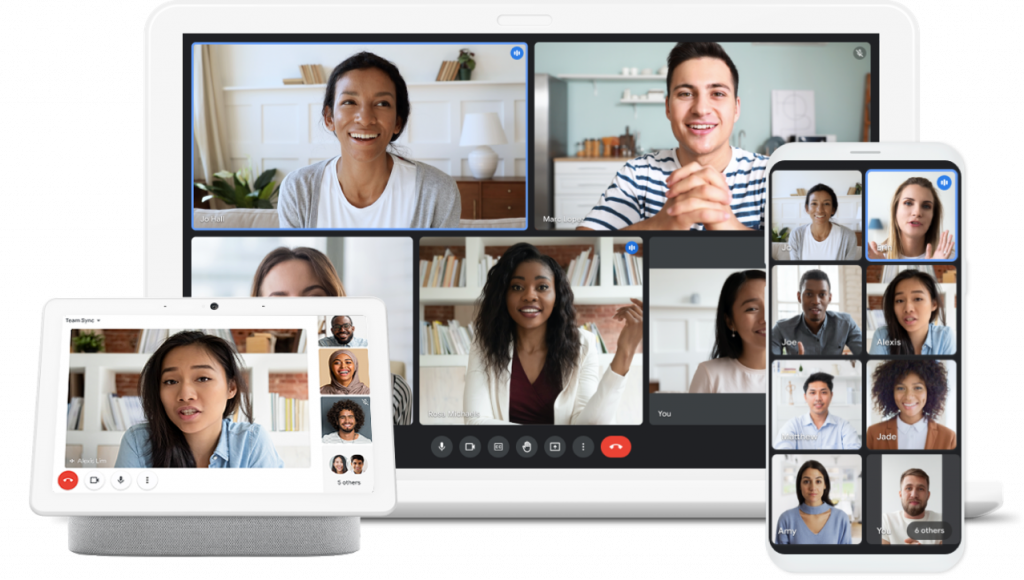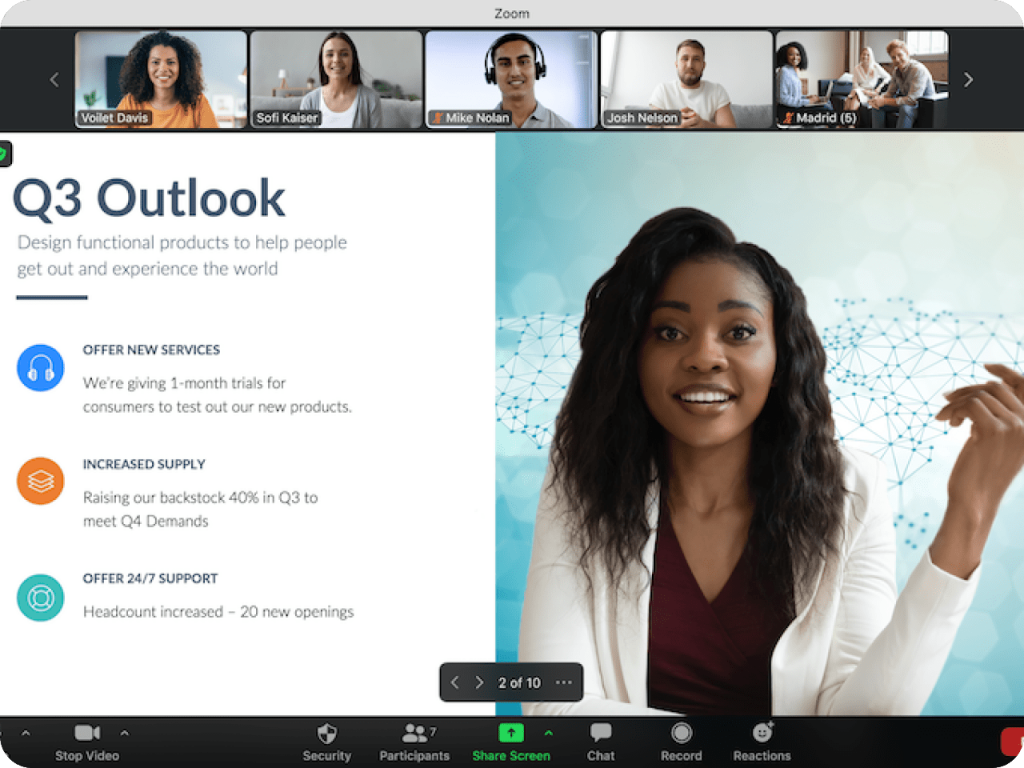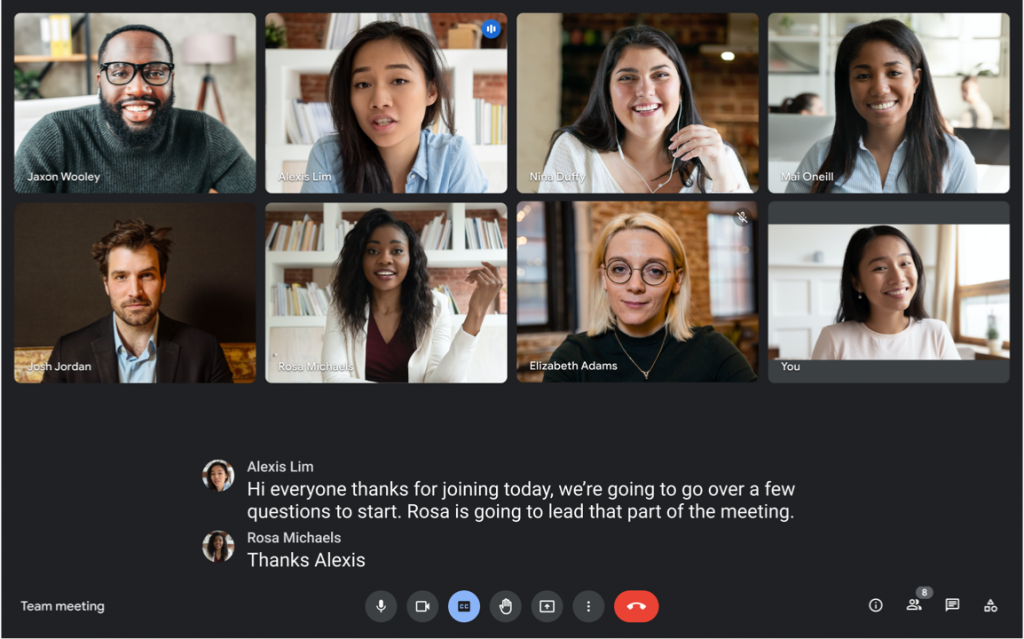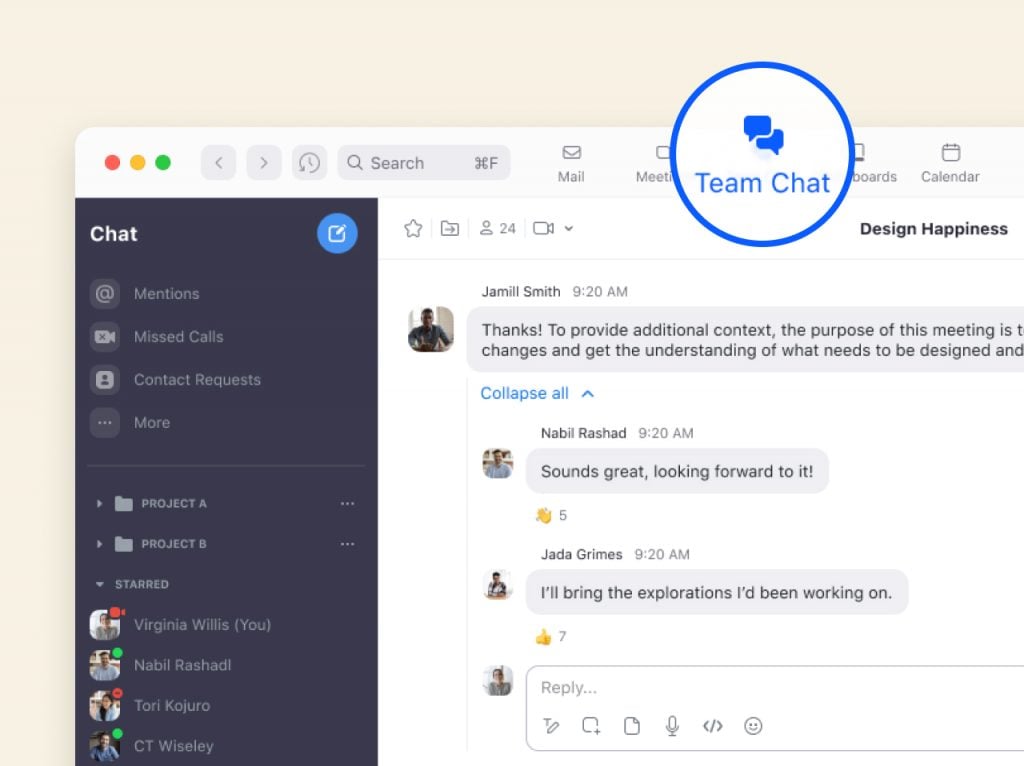Google Meet (previously Google Hangouts) and Zoom are two of the most popular video conferencing platforms, with millions of users worldwide. Both platforms offer a wide range of features, making them ideal for a variety of use cases, from remote work to virtual classrooms. Zoom became quite popular during the pandemic, but Google Meet knew how to gain a foothold and evolve. But which video conferencing platform is better to use in 2024? Keep reading.
Table of contents
Overview
| Feature | Google Meet | Zoom |
|---|---|---|
| Pricing | Individuals: Free Organizations: Starts at $6/month per user |
Individuals: Free Organizations: Starts at $15/month per user |
| Maximum meeting size | 100 participants (free plan) 250 participants (paid plans) |
100 participants (free plan) 1,000 participants (paid plans) |
| Meeting duration | 1 hour (free plan) Unlimited (paid plans) |
40 minutes (free plan) Unlimited (paid plans) |
| Video settings | Adjustable video resolution, frame rate, and lighting | Adjustable video resolution, frame rate, and lighting, as well as more advanced settings such as low-light compensation |
| Video quality | Excellent video quality, even on low-bandwidth connections | Excellent video quality, even on low-bandwidth connections |
| Audio quality | Excellent audio quality, with noise cancellation and echo suppression | Excellent audio quality, with noise cancellation and echo suppression |
| Screen sharing | Yes | Yes |
| Recording | Yes | Yes |
| Waiting room | Yes | Yes |
| Breakout rooms | Yes | Yes |
| Private messaging | No | Yes |
| Live transcription | Yes | Yes |
| Live captioning and subtitles | Yes | Yes |
| Whiteboard | Yes | Yes |
| Polls | Yes | Yes |
| Integrations | Tightly integrated with Google Workspace and several third-party apps | Integration with more than 1,500 third-party apps, including Google Workspace, Microsoft 365, and Slack |
Reasons to choose Google Meet

- Ideal for small organizations and individuals
- Integrated with Google Workspace
- User-friendly video conferencing
- Simplified meeting access
- Google AI-enhanced experience
- Efficient for Google Drive users
- Basic and direct features
Reasons to choose Zoom

- Suitable for larger organizations
- Stricter security expectations
- Accommodates more participants
- Advanced host controls
- Broad range of features
- High capacity for attendees
- Versatile and robust for various needs
⏩ Try Zoom
Google Meet vs. Zoom: Similarities
Google Meet and Zoom stand as two of the most prominent video conferencing platforms, each offering a suite of user-friendly features aimed at individuals and organizations. While these tools cater to distinct user bases and possess unique strengths, they also share many similarities that make them compelling choices.
User-friendly interface
Both Google Meet and Zoom prioritize ease of use. They feature intuitive interfaces that are easy to navigate, even for first-time users. This includes straightforward options for starting or joining meetings, managing participants, and accessing in-meeting tools.
Core video conferencing capabilities
Both Google Meet and Zoom excel at providing the fundamental video conferencing functionalities that drive virtual meetings and collaborations. They enable users to connect face-to-face with colleagues, clients, or friends, bridging geographical distances and fostering real-time interactions. Both platforms offer high-quality video and audio transmission, ensuring clear and engaging communication.
Video and audio quality
High-quality video and audio are essential for effective communication, and both platforms deliver in this regard. They offer HD video and clear audio, ensuring participants can see and hear each other without significant issues, provided they have a stable internet connection.
Screen sharing and presentation features
Effective communication often involves sharing visual content, and Google Meet and Zoom provide robust screen-sharing capabilities, even with third-party apps. Users can effortlessly project their desktops, presentations, or other visual aids onto the virtual meeting room, enhancing presentations and collaborative discussions.
Chat and messaging options
In addition to real-time video and audio, Google Meet and Zoom incorporate chat and messaging features to supplement communication during meetings. Users can exchange text messages, links, and files, facilitating side conversations and capturing important information.
Accessibility
Both Zoom and Google Meet offer various accessibility features to make video meetings more inclusive for people with disabilities.
Zoom provides live transcription, closed captioning, keyboard shortcuts, and integration with screen readers. Google Meet also has live captions, transcripts, keyboard shortcuts, and support for screen readers and magnifiers.
Additionally, Zoom and Google Meet enable users to remove video distractions by hiding non-video participants or turning off other people’s video feeds. This helps users focus on the speaker and reduces visual clutter.

Image credit: Google
Virtual backgrounds
To add a bit of personalization or privacy, both platforms offer the ability to use virtual backgrounds. This feature allows users to replace their real background with an image or video, which can be particularly useful in home working environments.
Recording meetings
Google Meet and Zoom provide options to record sessions for those who cannot attend a meeting or wish to review it later. This feature is invaluable for keeping records and for attendees who want to revisit important discussions.
Security and privacy features
Both platforms prioritize user security and privacy, employing encryption and access controls to safeguard meeting data and protect participants’ information. They offer various security measures, such as meeting passwords, waiting rooms, and host controls, to prevent unauthorized access and maintain a secure virtual environment.
Free and paid plans
Google Meet and Zoom offer free and paid plans, catering to individual users and businesses with varying needs. The free plans provide basic video conferencing functionalities, while the paid plans offer more advanced features, such as larger meeting capacities, enhanced security options, and extended recording capabilities.
Google Meet vs. Zoom: Differences
You should consider the differences between Google Meet and Zoom to know which is most suitable for your particular use case. Both video conferencing platforms are aimed at different organizational scales and user needs.
Meeting capacity
Google Meet and Zoom cater to different meeting sizes and organizational needs.
Google Meet’s free plan accommodates up to 100 participants, while its paid plans can support up to 250 participants. This makes it suitable for small teams and individuals who frequently host virtual meetings.
On the other hand, Zoom offers a higher meeting capacity, with its free plan supporting up to 100 participants and its paid plans accommodating up to 1,000 participants. This makes it a more scalable option for larger organizations and events that require a higher attendee count.
When selecting a video conferencing platform, carefully consider the average meeting size and potential growth of your team or organization. If you anticipate hosting larger meetings or events, Zoom’s higher meeting capacity may be a more suitable choice. However, for smaller teams and individuals who prioritize cost-effectiveness and integration with Google Workspace, Google Meet remains a compelling option.
Screen sharing
Google Meet’s screen-sharing interface is straightforward and easy to use. Users can quickly share their screen or specific applications with a single click, and participants can easily view the shared content on their devices. However, the app can only share the full screen, a browser window, or a tab.
Zoom offers more advanced screen-sharing options, such as:
- Sharing a secondary camera
- Sharing the screen of a mobile device
- Sharing one or more specific apps
- Playing a locally stored video
- Playing audio from a device
Host controls
Host controls are crucial in managing meetings effectively and ensuring a smooth and productive virtual collaboration experience. Both Google Meet and Zoom provide a range of host controls but differ in scope and granularity.
Google Meet’s host controls are primarily focused on basic meeting management tasks, such as:
- Muting and unmuting participants
- Removing participants
- Managing screen sharing
- Turning off screen sharing by participants
- Turning on and off chat for the entire organization
Zoom offers a more comprehensive set of host controls, providing greater flexibility and granular control over meeting management. In addition to the basic controls offered by Google Meet, Zoom hosts can:
- Lock meetings
- Disable screen sharing
- Restrict attendee participation
- Set custom passcode
- Restrict screen sharing to just themselves
- Allow only signed-in users to join a meeting
- Suspend participant activities
- Remove, disable video, or mute unwanted or disruptive participants
- Report any user to Zoom’s Trust & Safety team
- Turn off annotation and disable private chat for everyone
Google Meet’s host controls may be sufficient if you primarily host small to medium-sized meetings and prioritize basic meeting management tasks. However, if you frequently manage larger meetings, require stricter security measures, or need granular control over participant behavior, Zoom’s advanced host controls may be a more suitable choice.
Real-time collaboration
Both Google Meet and Zoom offer a range of real-time collaboration features, but they differ in their scope and capabilities.
Google Meet provides basic real-time collaboration tools, primarily focused on:
- Whiteboard
- Polls
- Live transcription
Zoom offers a more comprehensive set of real-time collaboration features, including:
- Whiteboard
- Breakout rooms
- Annotation tools
- Interactive whiteboards
- Live transcription and translation
- Shared notes
If you primarily host meetings that involve basic presentations and brainstorming sessions, Google Meet’s real-time collaboration tools may be sufficient. However, if you frequently engage in complex collaborative activities, require breakout rooms, or need advanced annotation tools, Zoom’s more comprehensive real-time collaboration features, like Team Chat, might be a better choice.

Image credit: Zoom
Security
Both Google Meet and Zoom prioritize security, implementing various measures to protect user data and safeguard meeting privacy.
Google Meet leverages Google’s robust security infrastructure, which includes:
- Data encryption
- Access controls
- Meeting passcodes
- Waiting rooms
- Two-factor authentication (2FA)
- Compliance
On the other hand, Zoom offers a comprehensive set of security features, including:
- End-to-end encryption
- Advanced meeting controls
- Customizable security settings
- User verification
- Security audits and penetration tests
- Bug bounty program
If you handle highly sensitive information or require advanced security protocols, Zoom’s end-to-end encryption and customizable security settings are something to keep in mind.
Platforms
Both Google Meet and Zoom are compatible across various platforms, including:
Desktop
- Google Meet: Web app
- Zoom: Windows, Mac, Linux
Mobile
- Google Meet: Android, iOS
- Zoom: Android, iOS
Web
- Google Meet: Chrome, Firefox, Safari
- Zoom: Chrome, Firefox, Safari
The main difference is that Zoom offers desktop apps for Windows, Mac, and Linux, while Google Meet is web-based and does not have a desktop app. Both offer mobile apps and web access.
Pricing
Google Meet’s pricing is as follows:
- Business Starter: $6 per user/month, 100 participants, 30 GB storage
- Business Standard: $12 per user/month, 150 participants, 2 TB storage, recording
- Business Plus: $18 per user/month, 500 participants, 5 TB storage, attendance tracking, Vault, advanced endpoint management
- Enterprise: Contact for pricing, 1,000 participants, 5 TB storage, noise cancellation, in-domain streaming, data loss prevention, enterprise endpoint management
Zoom’s pricing is as follows:
- Free: 40 minutes per meeting, 100 participants
- Pro: $15/month per host, 30 hours per meeting, 100 participants
- Business: $19/month per host, 30 hours per meeting, 300 participants
- Enterprise: Contact for pricing, 30 hours per meeting, up to 1,000 participants
Integrations
Google Meet integrates tightly with Google Workspace apps like Gmail, Calendar, Drive, Docs, and more. This provides a very unified experience for Google-centric organizations.
Google has also recently announced support for third-party integrations directly within the Meet interface, including apps like Figma, Miro, Lucidspark, and more.
Zoom offers integrations with over 1,500 applications, including:
- Google Workspace
- Microsoft 365
- Salesforce
- Slack
- Asana
- Dropbox
- Adobe Creative Cloud
Conclusion
In the end, Google Meet and Zoom both offer robust video conferencing capabilities and can meet the needs of many users. Google Meet’s tight integration with Google Workspace makes it a natural fit for existing Google customers. Zoom provides greater scale, strong third-party app integrations, and a broader range of features.
As productivity has gone increasingly digital, it’s valuable to connect the dots across the various services we use daily. Services like 2sync provide an effective means to connect Google Calendar events to Notion productivity suite. This helps keep the calendar and task tracking unified rather than siloed in separate systems, and also boosts your productivity.
Evaluating automations like these can streamline workflows further and maximize productivity when used alongside tools like Google Meet and Zoom. So, when choosing a video conferencing platform, consider how it aligns with your existing tool stack and business needs today, as well as where you anticipate growth in the future, including working with synchronization services.



